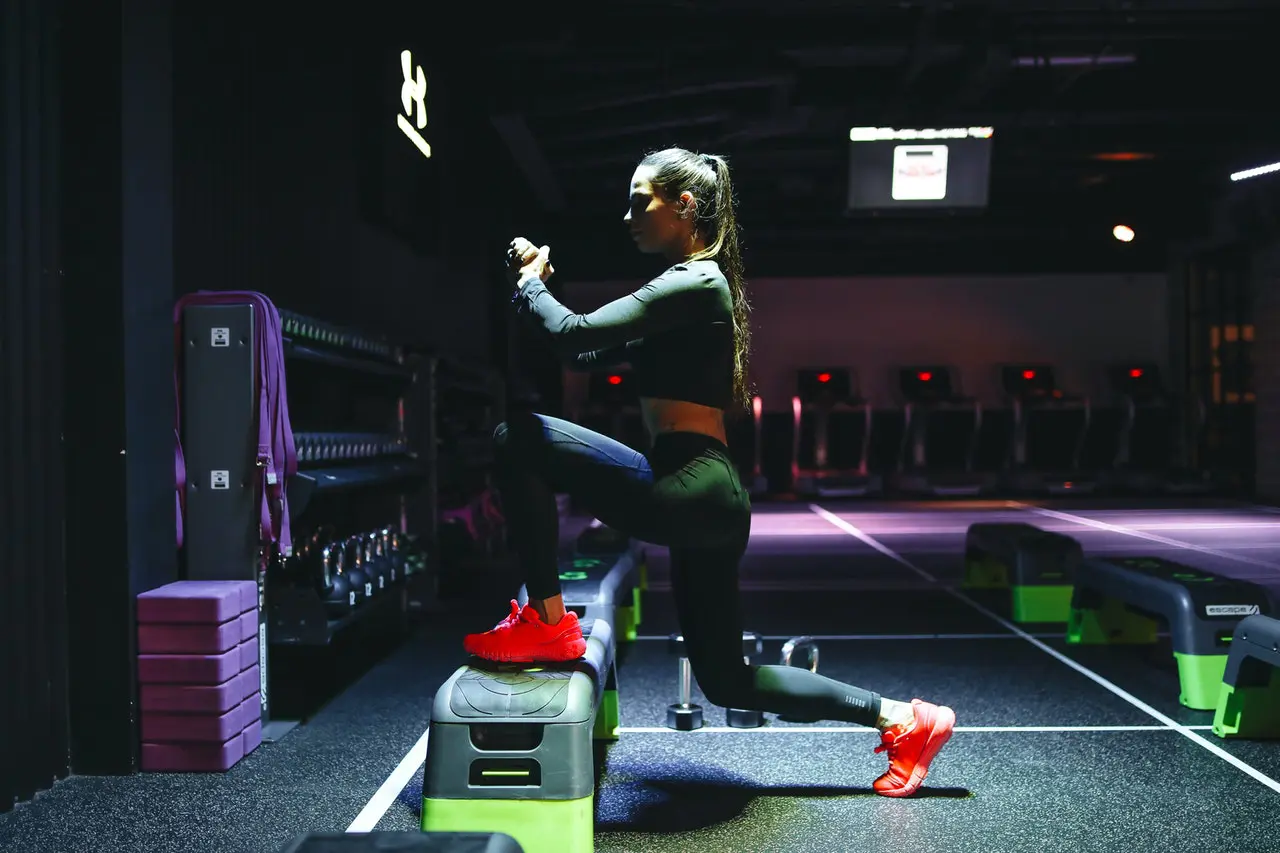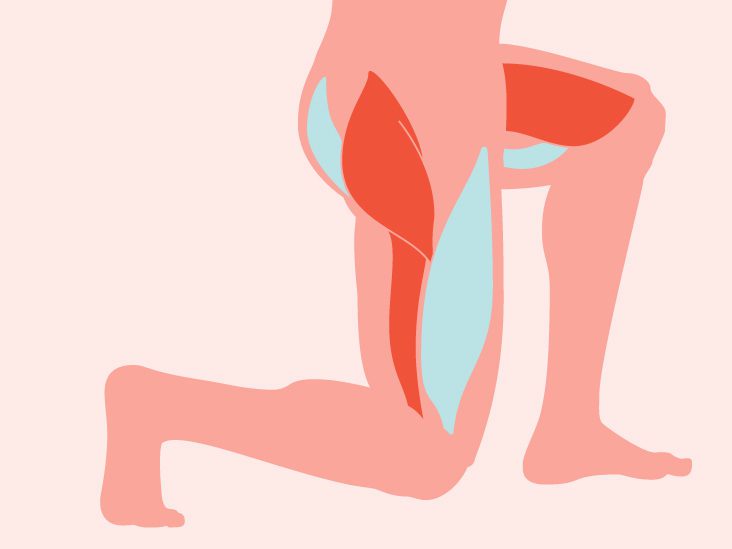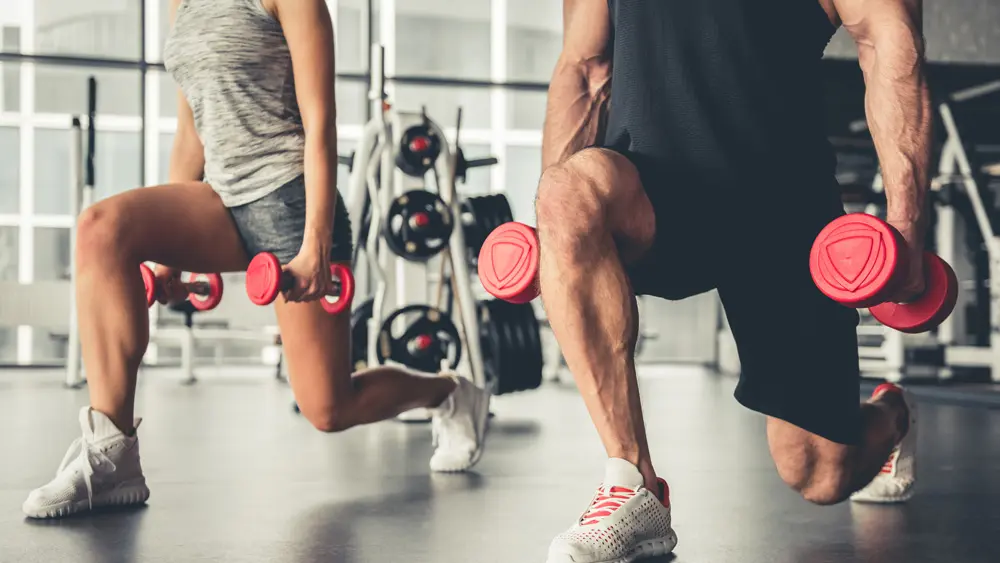
The best online fitness resource you'll ever need. We filter out the BS to ensure you meet your health and fitness goals!

The best online fitness resource you'll ever need. We filter out the BS to ensure you meet your health and fitness goals!

There are several reasons lunges might be your most needed exercise right now.
If you’re looking to build, shape or strengthen your legs- no matter your access to equipment, obviously sorely limited at the moment during the present Coronavirus lockdown- lunge variations are a must. Even when things go back to normal and you have full access to barbells and leg press machines, you should be incorporating medium weight lunges into your regular training in several forms.
As well, if you want to develop core strength and stability whilst improving range of motion and flexibility through your hips and quads, you need to be making the most out of your lunges. Lunging is a functional compound movement that will tax your neuromuscular system as well as putting a great deal of stimulation into your thighs. Whatever you have access to for training, you should be setting some time aside in every leg workout for some form of lunge variation.
This all being said, the times are what they are. Covid-19 lockdown has hit the world hard and gyms and training centres are mostly closed, so you will be having to make do with whatever exercises you can. Without barbells and squat racks, that means no PR for your low-bar squat; without a hack or leg press machine, that means no pressing triple your body weight for reps. Instead, bodyweight, or even lightly loaded, lunges are in order.
But what should these lunges look like? Well, variations come with different benefits, and some are harder than others, so we’ve taken the liberty of listing a few of the top lunge styles below. Try them all or look for what you think might best apply to you. They can all be done at home, in the garden, in the local park, all either with no resistance other than bodyweight, or with just a couple of light weights (dumbbells, bags of flour, a pillow full of rocks… anything you can muster) in each hand.
These are mostly ranked in no particular order- they will all be good and are all worthy of consideration. That being said, there is something of a winner here: let’s kick off the list with a special mention, a variation that stands head and shoulders above most lower body exercises for stimulation and mass-building potential…
These are the king of leg exercises, putting a great deal of stimulation into your glutes and hamstrings, whilst simultaneously working your legs through a large range of motion with a great deal of carry over into most other athletic disciplines.
You need plenty of room to perform walking lunges. They can be weighted or unweighted, but either way you want to start with your arms in a neutral position by your sides. Begin with your feet shoulder width apart, step forwards with one foot and drop the opposite knee down into a lunge. Step forwards, repeating on the other side. Keep lunging in this way- walking, essentially- for the required number of reps (or until you run out of room!)

There is nothing too special about the reverse lunge (other than its fantastic mass-building potential, especially through the glutes!) However, it is a staple, and can be performed on the spot, making it perfect for training at home.
There is no impact and your joints should feel healthy and comfortable throughout. Starting in the same position as with a walking lunge, simply step back with one foot, lunging the knee down until it is about an inch from the ground. Return to the start and repeat on the other side for the required number of reps.
The reverse lunge can also be completed with a slider. Rather than stepping back into each rep, place your foot onto the slider, with your toes in the middle and your heel off the ground. Simply slide back and drop your rear knee towards the ground, stopping an inch from the floor. Repeat for the desired number of reps on one side, then switch to the other leg.
Pendulum lunges are a little bit advanced, but they are perfect for testing and training your coordination, balance and hip mobility.
Once more, these can be performed on the spot, so are perfect for training at home with limited space.
To perform the movement, step forwards and drop your rear knee into a lunge, as you would for a walking lunge. Then push off your front leg, coming back to the start position. However, before you touch your foot back to the ground, immediately perform a reverse lunge with that same leg. From here, lunge forwards once more, and continue, trying not to touch your foot down in the middle.
One lunge forward and one back is one rep.
These are great for beginners and can be set up at home by attaching a set of TRX ropes, or any other kind of rope or suspension pulley, to a secure mount. Hold the handles or ropes in each hand and use them for assistance.
From here, follow the instructions for reverse lunges detailed above, but using your arms and the ropes to aid with balance, and to help you come up out of each rep as you tire.
If anything could knock walking lunges off the top spot, it might be split squats. They are a potent leg builder and take little equipment. They are perfect for a full gym session, working as an accessory after heavy squats, or for home gym training.
Begin in front of a bench or chair that should come to a few inches below your waist. Facing away from it, place one foot behind you, on the bench. The other is your active leg. For each rep, dip the rear knee down, squatting on the spot with your front leg.
This exercise will give you a great stretch in the rear leg, whilst building serious quad and glute strength. If needed, have another chair or bench beside you to hold onto for support.

Whenever you want to make a bodyweight exercise harder, add a jump. This applies to squats and push ups, and jumping, plyometric versions of each are a common sight. However, jumping lunges are also crucial to any well-rounded lower body routine.
Jumping lunges are quite advanced, so make sure you’ve mastered the basics listed above before you give them a go.
Begin by getting into a lunge position, with your front knee at a right angle and your rear knee an inch from the ground. Jump up explosively, so that you leave the ground. As you leave the ground, switch legs, so that the front knee becomes the rear and vice versa as you land. Repeat. This is one rep.
Try to reduce impact by wearing sensible footwear and try to keep your knees soft. If your knees hurt, or if you find yourself losing control and landing the rear knee on the ground, consider trying a different variation.
No conversation on lunge variations would be complete without a thorough digression into what makes lunges so important to your training. Whatever your goal, if you regularly hit the weight room, or if you are involved in any form of athletic or explosive endeavour, you need to be doing them.
Why? Well, please read on:
As we have just seen, there are plenty of lunge variations. We’ve barely scratched the surface, either. The list above are just six of the best variations going: there are plenty more. They can be programmed for many fitness goals, too. Go for medium range reps, hitting sets of 6-8 under load, for strength. Go longer for endurance or hypertrophy, keeping it in the 10-16 range. Go with explosive jumps if you’re a sprinter, or gentler, slower ones if you’re a budding yogi.
They can also be done anywhere, as mentioned above, at any time, with little to no equipment. At times like these, where access to training facilities is severely restricted, this is a boon.
Even when lockdown is lifted, this aspect will have merit. If you are busy and don’t have time to get to the gym, or if you’re watching the pennies and can’t justify paying for a gym membership, look to lunges. Whilst sports and classes need you to work to their timetable, and even the weights room takes time to journey to, lunges can be done in your living room or office whenever you have a minute, at no cost.

Lunges build big legs. Champion squatters swear by them: your squat is there to test and build strength, but much of your muscle mass will be coming from lunges, meaning that they will lend you size and strength. If you’re not currently including lunges in your regular routines, you are missing out on a lot.
Lunges also train all three of your glute muscles alongside the muscles in your legs. Glutes are vital for healthy walking and running, and keeping them strong and mobile will give your athletic career and general mobility alike much greater longevity.
As you will no doubt find when attempting some of the above exercises, one of the most challenging aspects of performing lunges is the balance and coordination needed. Funnily enough, this is often worse the less weight you’re under: bodyweight lunges are way harder to keep upright during than weighted lunges.
Lunges are a unilateral exercise, as opposed to leg press and squat variations that are bilateral. They use one side of your body- one leg- at a time, as opposed to using both. This works balance, which relies greatly on proprioception. Proprioception relates to the parts of the body that respond to your body’s position in space in order to counteract position changes and shifts in weight and balance.
Working proprioception will improve balance, and little in the weights room or anywhere else works your proprioception as much as lunges do, training your body to better, more readily and more speedily react to positional changes. Training them regularly will bring much improved balance and coordination to just about every other move and exercise that you can put yourself through.
We’ve all seen it, and most of us have done it: squatting asymmetrically. One leg often takes over and lifts 70% of the load whilst the other slacks off. It’s perfectly natural to do: most of us have a dominant leg, with greater strength and neuromuscular control, so we will all favour one over the other.
This is where lunges come in. They can help you to overcome muscular imbalances in your lower body, whilst simultaneously working the mind-muscle connection in each leg individually, whatever variation you choose.
If you have one leg that is weaker, smaller, or injured, lunges should be a priority. Over time, muscle imbalances can cause injury, especially in your legs, as joints are pulled out of alignment. If this happens across your pelvic region, as happens with asymmetrical squats all too often, you could be facing significant hip and/or lower back pain later in life.
There is also a performance issue, here. If one leg is doing all the work… well, only one leg is doing all the work. One weak leg makes your lower body’s overall strength lesser. Build up the mind-muscle connection and muscle mass in your weak leg and the sum of all parts will be greater: your will have much more muscle tissue to call upon and your squat numbers will spike.

The idea of ‘functional fitness’ is bandied about too regularly. After all, if an exercise can make you stronger, it is functional. Most exercise does, so most exercise is functional. However, lunges take this to the next level.
As mentioned above, the effect of training lunges on your glutes and hips is incredible. They will allow you to walk taller, more proficiently, with greater longevity than just training bilaterally alone. Lunges mimic walking under load, readying the body for everyday tasks like climbing stairs and walking uphill. These both become a lot easier for the regular lunger.
Hip flexibility is also a big contributor to back pain, especially as we age. Modern lifestyles, and the lifestyles we often fall into in middle age, including plenty of sitting and little exercise, worsen this issue. Lunges reverse it, giving a strength boost to the hip joints and regularly stretching them through a full range of motion.
Lunges are also great for you spinal health, furthering the benefits they can bring to your hips and back. This is down to spinal deloading- a crucial, yet often overlooked, aspect of training. Many exercises place great loads on your spine: think of squats, leg presses and deadlifts, alongside standing upper body compound movements like overhead presses and rows. Add the stress of carrying a rucksack or handbag around all day, or any exertion caused in a physical job, and the compressive power going into your spine is quite phenomenal.
This is no bad thing in itself. In fact, it is very beneficial. Your spinal muscles need to be loaded and worked as much as any other muscle group, and will stay stronger, for longer, in such conditions.
However, deloading also needs to occur. Just sticking to exercises with a harsh compressing load can cause damage over time, as well as leading to inflexibility. Lunges draw back from this, allowing you to generate intensity through your legs, with high stimulation and training effect, without putting so much tension through your spinal column.
The fact that you are moving and flexing key joints that relate to your back- your lumbar spine and your hips, primarily- without load will go a long way to reversing the negative effects of compression. Your body will have a chance to bend and stretch, improving blood flow and mobility.
There really is no reason to skip the lunges. If you want a good workout at home, they will be essential. Even though you may not have access to hundreds of kilograms of plates, a sturdy barbell and a squat rack, you can still work your legs, bring about strength and hypertrophy gains, and even find some of the hidden benefits listed above.
Things never need get boring, either: we have several variations listed here for you to try, so that no two workouts need to be the same.